
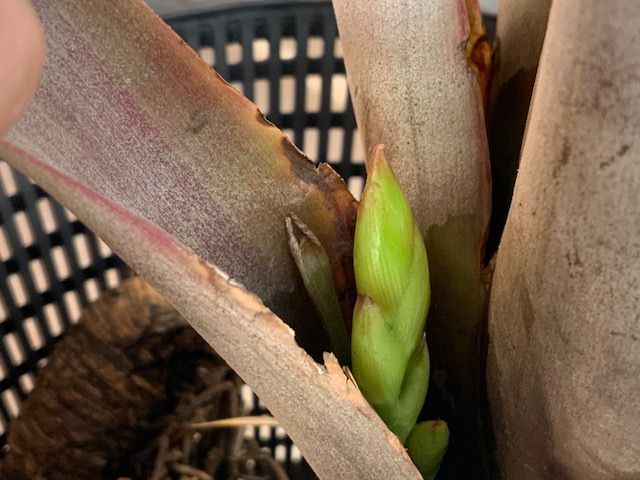
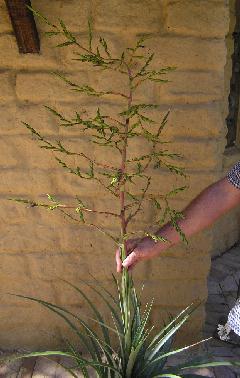
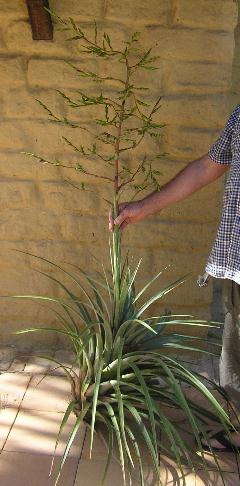
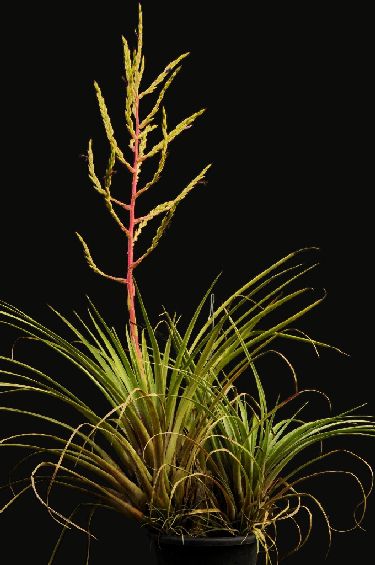
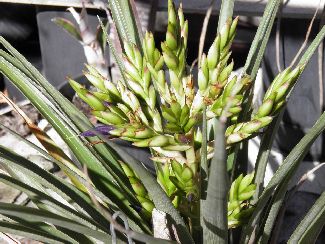
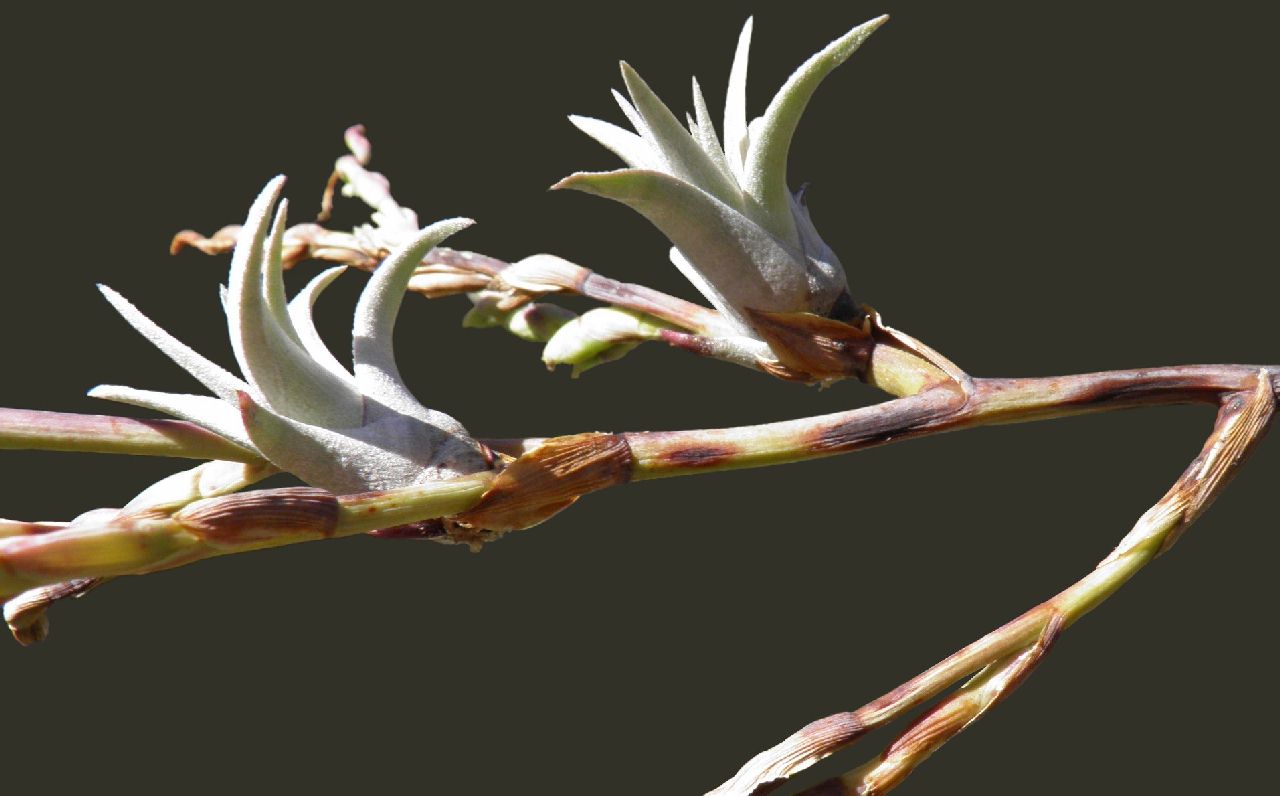
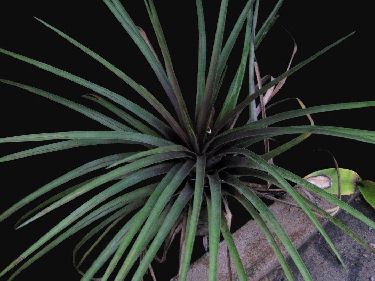
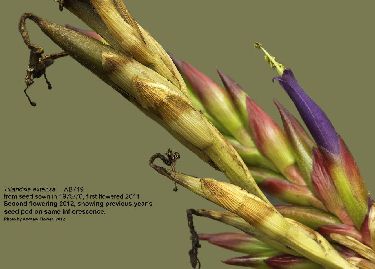

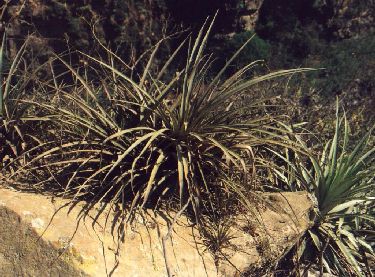
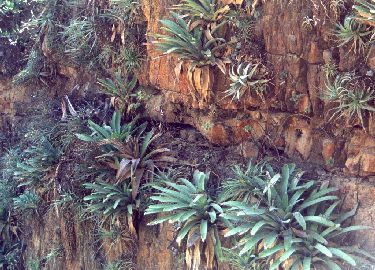
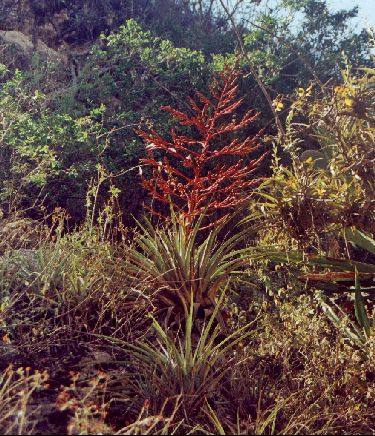
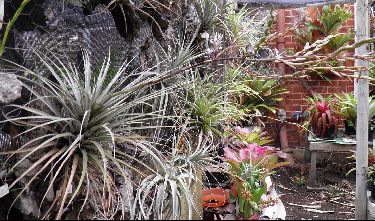
Bruce Dunstan, 26/04/13 4:53pm.... Derek, do you know where you sourced your plant from ? I have a very silvery plant from Peter who got it from Knize that is in spike at the moment, but no ideas on viviparous pups.
Derek Butcher.... Bruce. Surprise surprise. Mine came from Knize about 30 years ago as hitchcockiana. It seems a smaller more silvery extensa than what you lot grow in the east. Perhaps I should get used to pseudoviviparous.
Ray, 26/04/2013 4:05pm.... Derek, not knowing what viviparous meant, I used the wonder of the iMac to inform myself as copied and pasted below, does this mean that the buds formed whilst flowering or on the old flower spike after flowering? As for T extensa, I have no prior knowledge of it's habits. In plants, it means "reproduction via embryos, such as buds, that develop from the outset without interruption, as opposed to germinating externally from a seed."
Derek Butcher, 26/04/2013 4:13pm.... Newbies please note. Bromeliaceae terms have been influenced by Americans (Viz Lyman Smith) which is why I concocted a Glossary so I can swot up from time to time. This is why I have a Glossary on the Tillnuts DVD. You can ponder whether I was correct in using viviparous and not pseudoviviparous! In my thirst for such valuable knowledge I am now trying to trace what phyllanthidea means. Mez used this word in 1896 and nobody so far including David Benzing (who loves to use long words) has been much help. It was used as a genus name in Euphorbiaceae in 1857 and Euphorbia have some odd flowers. I haven't given up yet.
Bob Hudson, 26/4/13 6:27pm.... Here is a photo of Tillandsia extensa I got from Grace Good many years ago.
Andrew Flower, 27/04/13 5:28pm.... My T. extensa has no offsets on the infloresence UD, but it does flower in successive years on the same inflorescence - see pic.
This plant was grown from seed I received in 1975/76 with a Rauh collection number on it. Unfortunately the number got lost over the years. It flowered for the first time in 2011 (do the math!) and again on the same inflorescence in 2012. It is self fertile but (again doing the math) I decided not to bother sowing seed of it this time. It also pups profusely.
Derek Butsher, 28/04/13 7:47pm.... Andrew, I thought that only Deuterocohnia were supposed to do that. Will add your photo to the Tillnuts DVD if only to prove that nature knows no rules!
Peter Tristram, 29/04/13 12:30pm.... Photos of T. extensa from home and habitat shots (Chongoyape Peru).
For me extensa frequently blooms for a second year, usually after appearing to stop, seed pods set as well, either on new branches or extensions of the original ones, but I can't remember a third or more season of blooming. I have never had viviparous whatever pups on them either and I would like to see a photo of the whole of Derek's plant in case it's a mima v. chiletensis or some other similar species. It doesn't look like propagulifera though.
I'd also love to see the plant Bruce is blooming (hint) as we might be able to figure out what it is. All of my forms (Knize, Heidelberg, BRT, Tropiflora, self-collected and probably a few more sources) give adventitious pups.
Attached are few pics of it in habitat and a plant from that site blooming at sunny Repton. This extensa was collected in 2003 on the other side of the range to where T. mima v chiletensis grows, in a gorge as you head into the Andes inland from Chiclayo, near Chongoyape - so it has provenance! It is actually mounted, though I usually pot these terrestrial types, as I decided to stunt it. The cliff pic features species like T. teres, extensa, hitchcockiana/cereicola, R. multiflora and some spiny stuff.
Derek Butcher, 29/4/13 2:44pm.... Photo of whole plant, now labelled T. mima v. chiletensis
Peter, you have it in one. I am now fairly certain I do have T. mima v. chiletensis. Photo of plant attached. When taking the photo I noticed that flowers were distichous leading to T. extensa but on branches now becoming herbarium material they were clearly secund pointing to T. mima! All of this needs recording for future queries!
Peter Tristram, 1/05/2013 06:34pm.... Derek, the viviparous bit got me thinking so I checked your inflorescence against a T. mima v. chiletensis in my greenhouse and decided it just had to be. This is a very slow species for me and I really need a drier spot for them. I saw huge ones in Germany too where they must take a lifetime to bloom.
Derek Butcher..... You think yours are slow. Mine took over 30 years! 5 years back Adam Bodzioch used Ethrel and got a one branched spike and a single flower which I identfied correctly. My plant took a further 5 years to do its thing naturally and got wrongly identified as T. extensa.!
That's the way the cookie crumbles >:-}

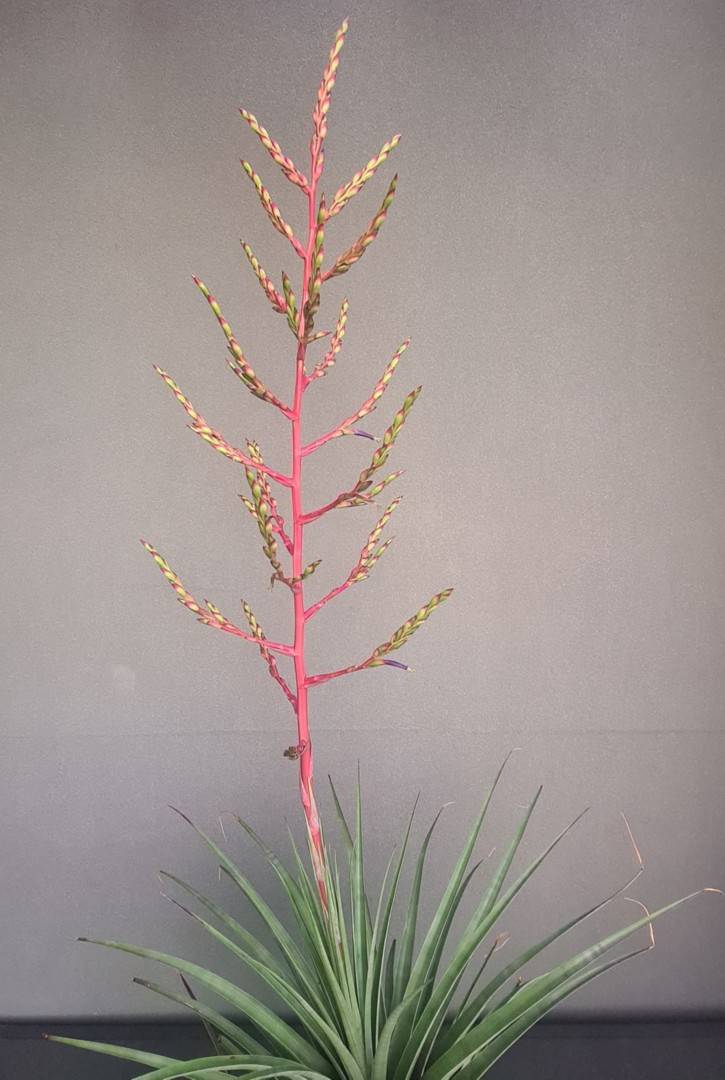
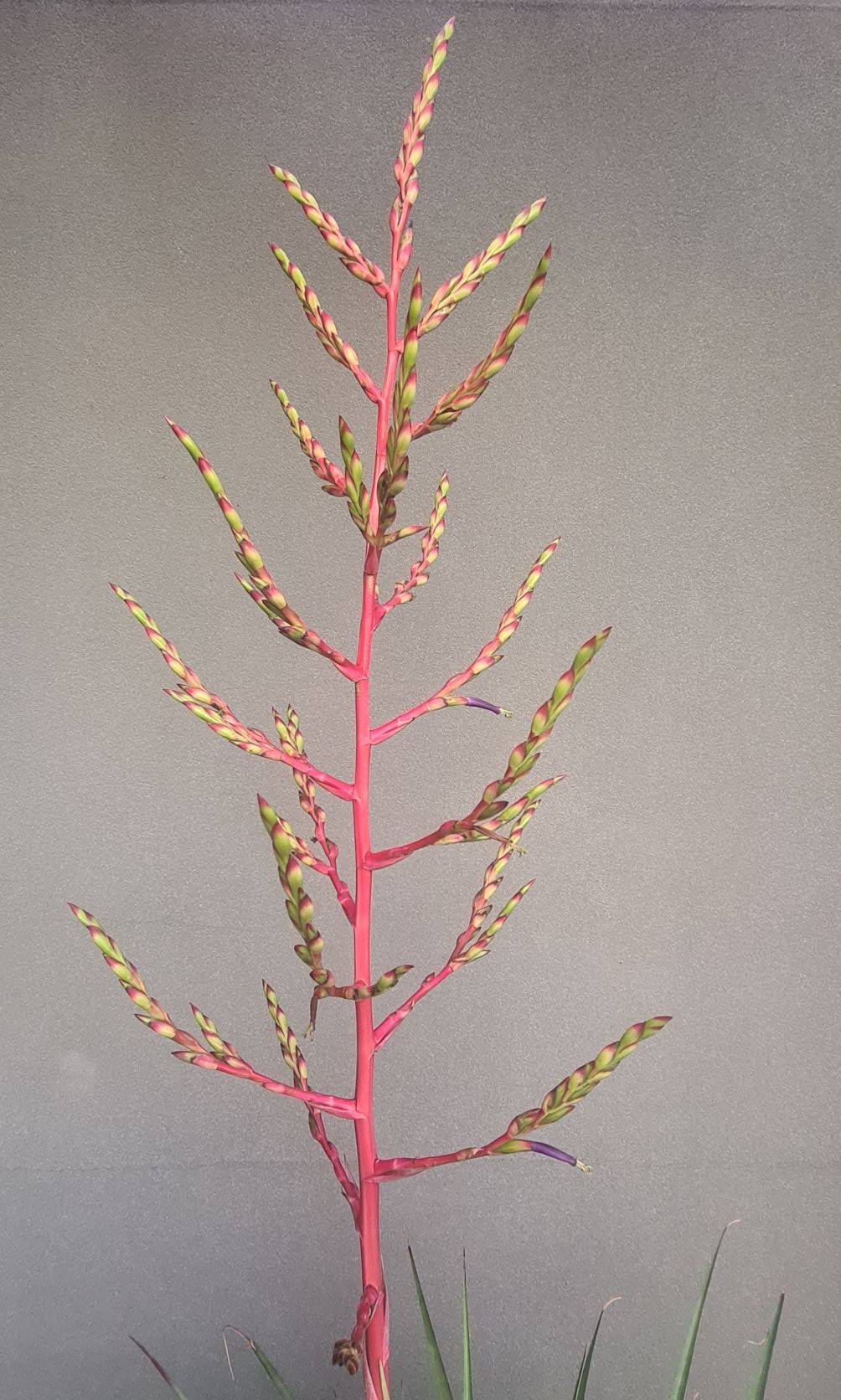

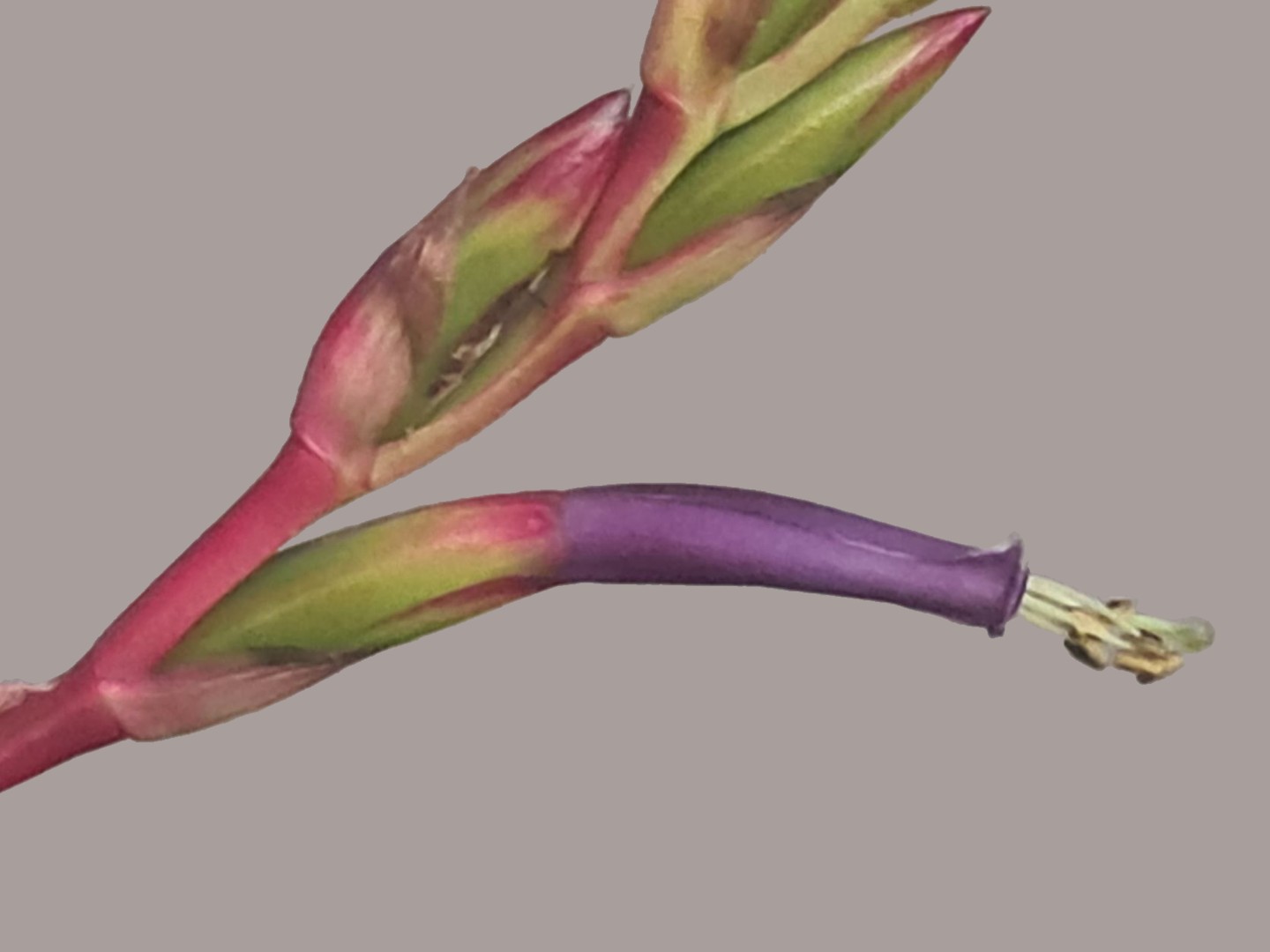
Tillandsia extensa Mez (1906), emend. Rauh Akad. Wiss. & Litt. Mainz 1973(3): 29, figs. 16a--c, 17. 1973.
T. extensa for a long time in Peru has been based on a collection made by the botanist A. Weberbauer in central-Peru, in the Dptm. Ancash, above the village Masin (Prov). Huari, at 2500 m. Since then the plant was regarded as missing and was not found again; however, it was rediscovered by me (1970) in North Peru in the valley of the Rio Sana near Chiclayo (N-Peru), growing on steep rock walls, at 500 m high. After the examination of my material by L. B. Smith it was agreed that it was similar to that collected by Weberbauer in central-Peru, so that the incomplete description in Mez (1906) can properly be amended accordingly:
Planta acaulis, basi plantis adventitiis numerosis, in statu florendi usque ad 1,6 m alta. Folia numerosa, erecto-patentia, apice reflexa, rosulam usque ad 80 cm altam et 80 cm diametientem formantia. Vagina 18-20 cm longa, 6-7 cm lata, supra badio-lepidota, subtus laetius badio-lepidota, indistincte limitata. Lamina usque ad 60 cm longa, 2 cm lata, paulatim in apicem longum tenuem excurrens, utrimque dense appresso-cano-lepidota, subtus subtiliter nervosa. Inflorescentia usque ad 1,6 m longa. Scapus solidus, usque ad 70 cm longus, 1,5 cm diametiens, glaber vel modice lepidotus. Bracteae scapi eo appressae, basales foliis similes, laminis anguste linearibus cano-viridibus internodia superantibus, superiora breviora, late triangulata, acuminata, punicea, modice lepidota. Inflorescentia late pyramidalis, plus minusve 60 cm lata, 50 cm longa, axe recto, leviter angulari, puniceo; rami paniculae rectangulariter patentes, semel vel bis ramificati, superiores erecti. Bracteae primariae multum breviores quam pars sterilis foliosa ramorum, superiores tam longae quam pars sterilis vel longiores, triangulato-acuminatae, puniceae, modice lepidotae. Bracteae secundariae longiores quam pars brevissima sterilis ramorum, late triangulatae, plus minusve 2 cm longae, 1 cm latae, acuminatae, margine membranaceae, puniceae. Spicae usque ad 25 cm longae, 10-15 cm latae, laxi-vel densiflorae, axe tenui applanato, puniceo, basi internodiorum 5-10 mm longorum modice alato. Bracteae florales erectae, ecarinatae, tantum apice nerve mediano proximulo leniter carinatae, acuminatae, plus minusve 20 mm longae, 8 mm latae, rigidae (in statu sicco nervosae), glabrae, supra disperse lepidotae, basi virides, apice et marginibus puniceae, sub anthesi breviores quam calyx. Flores sessiles; sepala 20-22 cm longa, usque ad 10 mm lata, acuminata, basi breviter connata, rigida, viridia, apice leniter nervosa. Petala sepala superantia, anguste linguiformia, caeruleo-violacea, tubum angustum formantia; antherae et stylus exsertae. Fructus virides, usque ad 5 cm longi, obtuso-triangulares.
Habitat: Peruvia septentrionalis, in rupibus in valle fluminis Rio Sana apud 600-700 m. s. m.
Sammel-Nr.: Rauh 24168 (Aug. 1970) in (HEID).
Plant stemless, at the base with numerous adventitious offsets, flowering to 1,6 m high (fig. 16b).
Leaves numerous, erect to spreading, bent over at the top, formiing a to 80 cm high and 80 cm diam. wide rosette ( fig. 16a-b).
Sheaths 18-20 cm long, 6-7 cm wide, upper side dark brown , underneath light brown lepidote, not distinct from the blade.
Blades to 60 cm long, ±2 cm wide, gradually tapering to a long, thin tip, grey to reddish green, both sides dense appressed lepidote, both sides later glabrous, underneath fine nerved; edges bent inwards at base.
Scape to 70 cm long, 1,5 cm thick, glabrous to scattered lepidote.
Scape bracts adjacent to the scape, the basal ones subfoliate, with long linear, grey green, lepidote, blades that exceed the internodes (fig. 16b), the upper ones shorter, wide-triangular, acuminate, carmine red, scattered lepidote.
Inflorescence tri-pinnate, wide-pyramidal, (fig. 16 b-c), approximately 60-80 cm broad and 50 cm long with straight, weakly edged, carmine red axis; the basal branch spreading at right angles, branched, the upper ones erect and mainly not branched.
Primary bracts of the basal branch much shorter than its sterile, bracted section, (fig. 16c), the upper branches as long or longer than its sterile section, triangular, acuminate, carmine red, scattered lepidote.
Secondary bracts longer than the short sterile section, wide-triangular, ± 2 cm long, 1 cm wide acuminate, membranous at the edge, carmine red.
Spikes to 25 cm long, 10-15 mm wide, lax to dense - and many flowered, with thin, flattened, carmine red, at the base of the 5-10 mm long internodes weakly winged axis (fig 17).
Floral bracts erect, ecarinate, only at the top with a prominent mid-nerve indistinctly keeled, acuminate, ± 20 mm long, 8 mm wide, robust, (clearly nerved when dry), glabrous, upper side scattered lepidote, at the base green, at the top and at the edge carmine red, at anthesis and postfloral shorter than the sepal (fig. 17 II-III).
Flowers sessile;
Sepals 20-22 mm long, to 10 mm wide, acuminate, short connate, robust, green, at the top weakly nerved.
Petals widely exceeding the sepals, narrow tongue-shaped, blue violet, forming a tube.
Stamens and Style far protrude, (fig. 17 II).
Fruit green, to 5 cm long, blunt-three-edged, (fig. 17 III).
On rocks in the valley of the Rio Sana, North Peru, 600-700 M.
Collection number Rauh 24168 (Aug 1970), in HEID.
On the basis of this new discovery T. extensa appears to have an essentially further range, than previously known. It is assumed that there is a certain variability in altitude with our collection of larger plants at 500m compared to that collected by Weberbauer at 2500m
{Does this have any connection? Clearly Rauh is speaking of a larger plant but it still can be accommodated in the amended description as above rather than linking it to T. platyphylla !}
From Werner Rauh on “Notes on Peruvian Tillandsias” in J Brom Soc 24(6): 208. 1974
One of the largest species we found in the region of San Ramon is shown in Fig. 6. It is closely related to Tillandsia platyphylla and forms big rosettes. The long, narrow-triangular, densely brown lepidote leaves possess big dark brown sheaths; the scape is thick and stout, and the amply tripinnate inflorescence reaches a height of 2 m and more. The primary branches are long stipitate, the axis of the spikes is very thin and flexuous; the blue violet flowers are laxly arranged. T. platyphylla does not grow only on trees, but also on steep rocks at an altitude between 1,000 and 1,500 m.